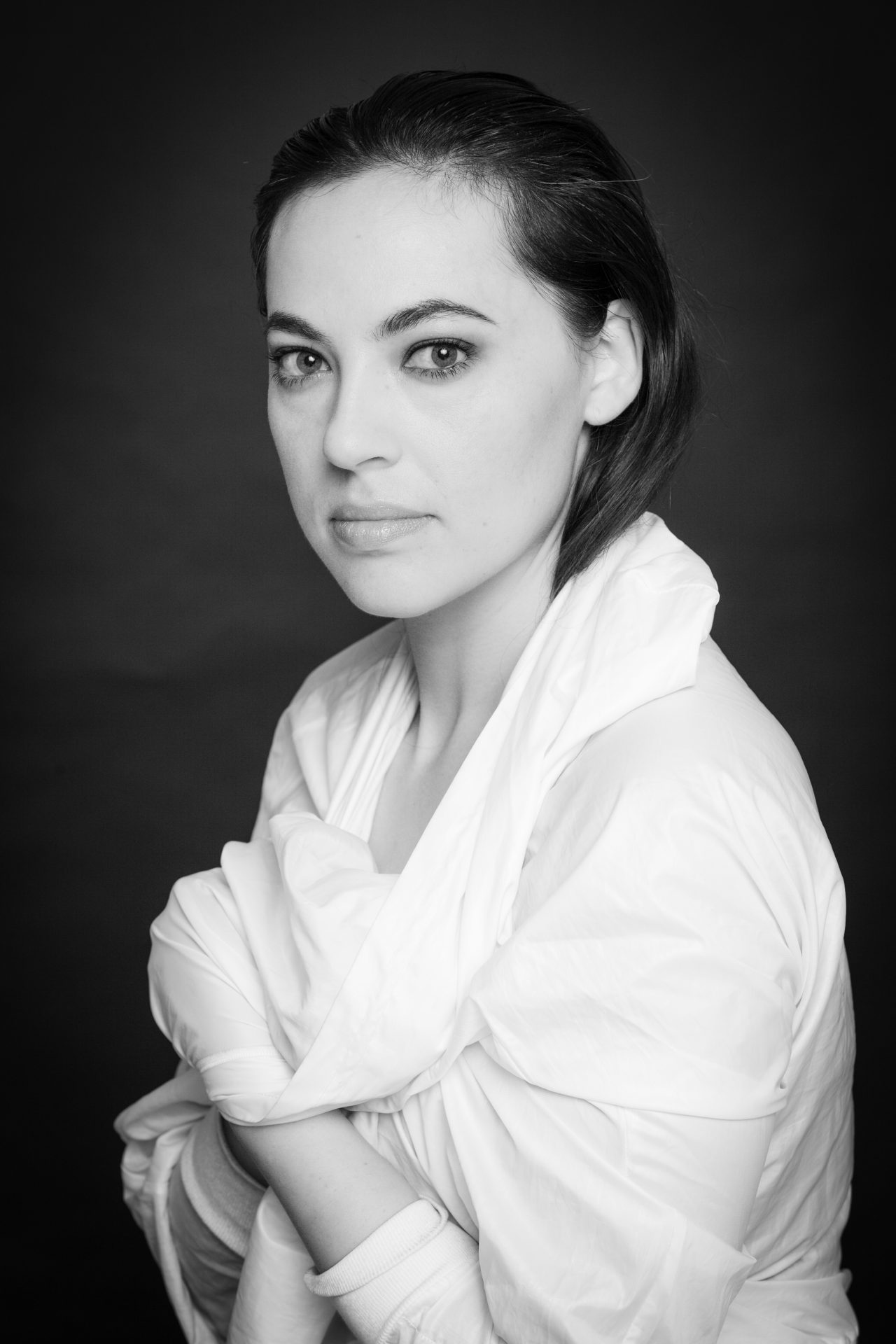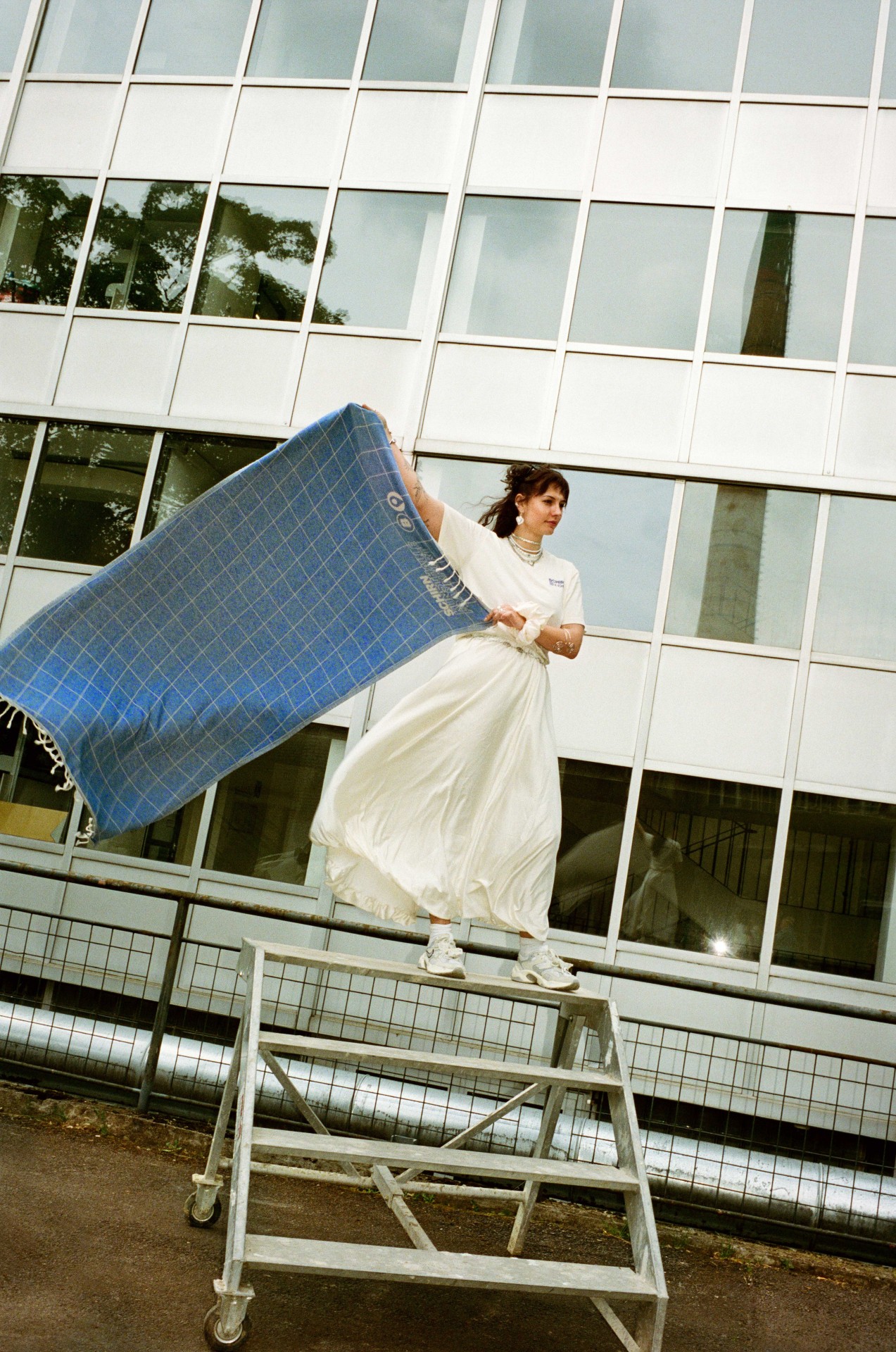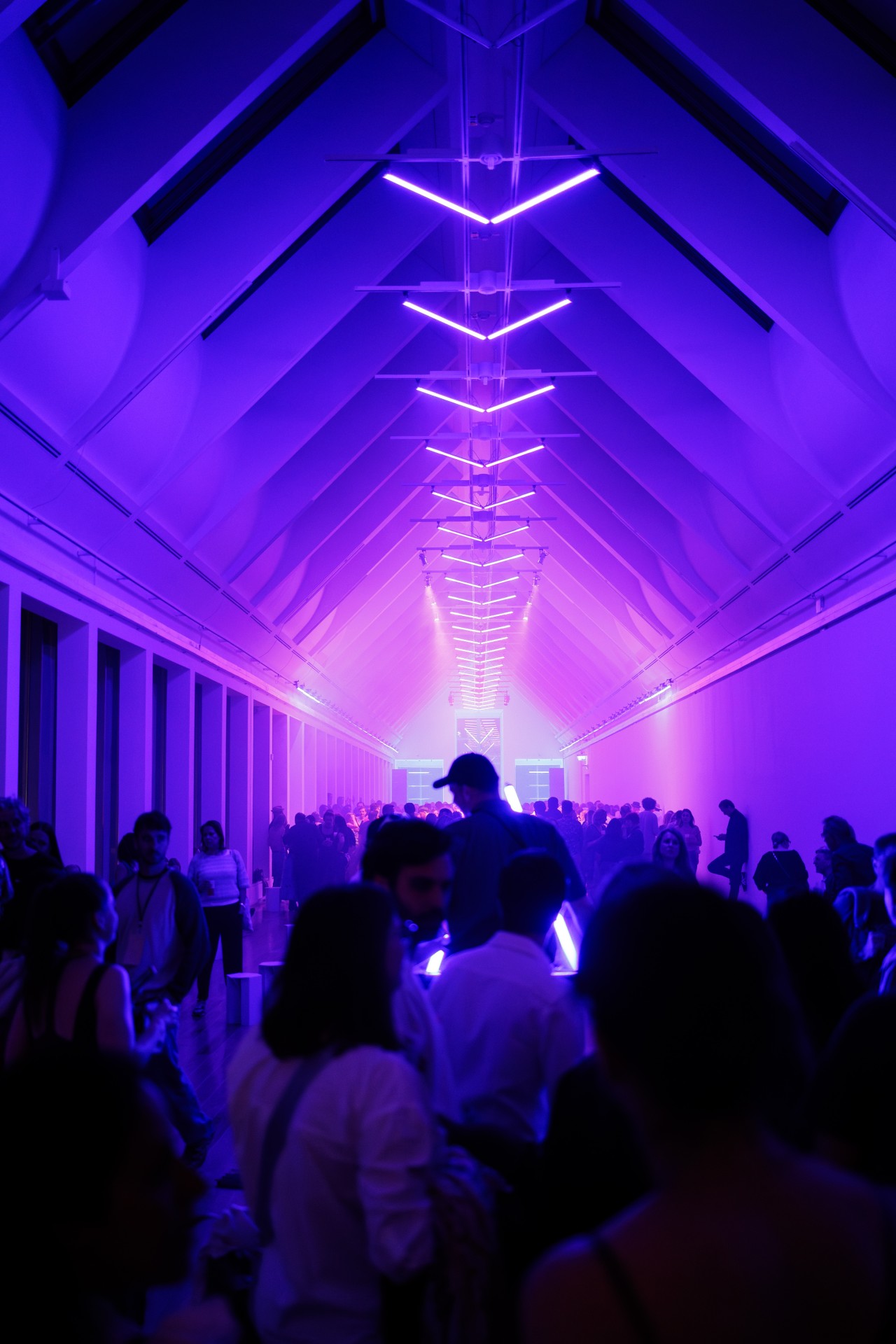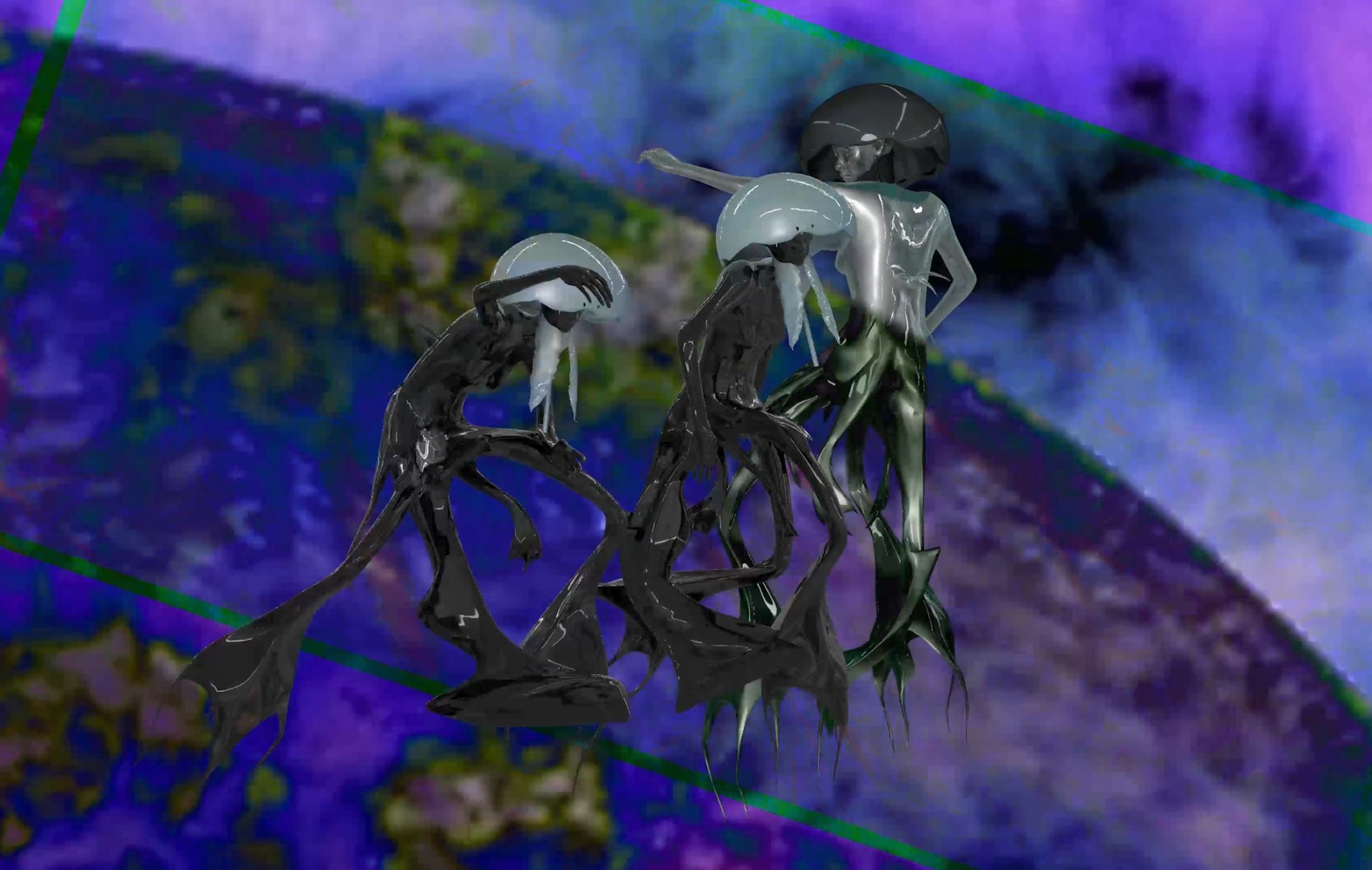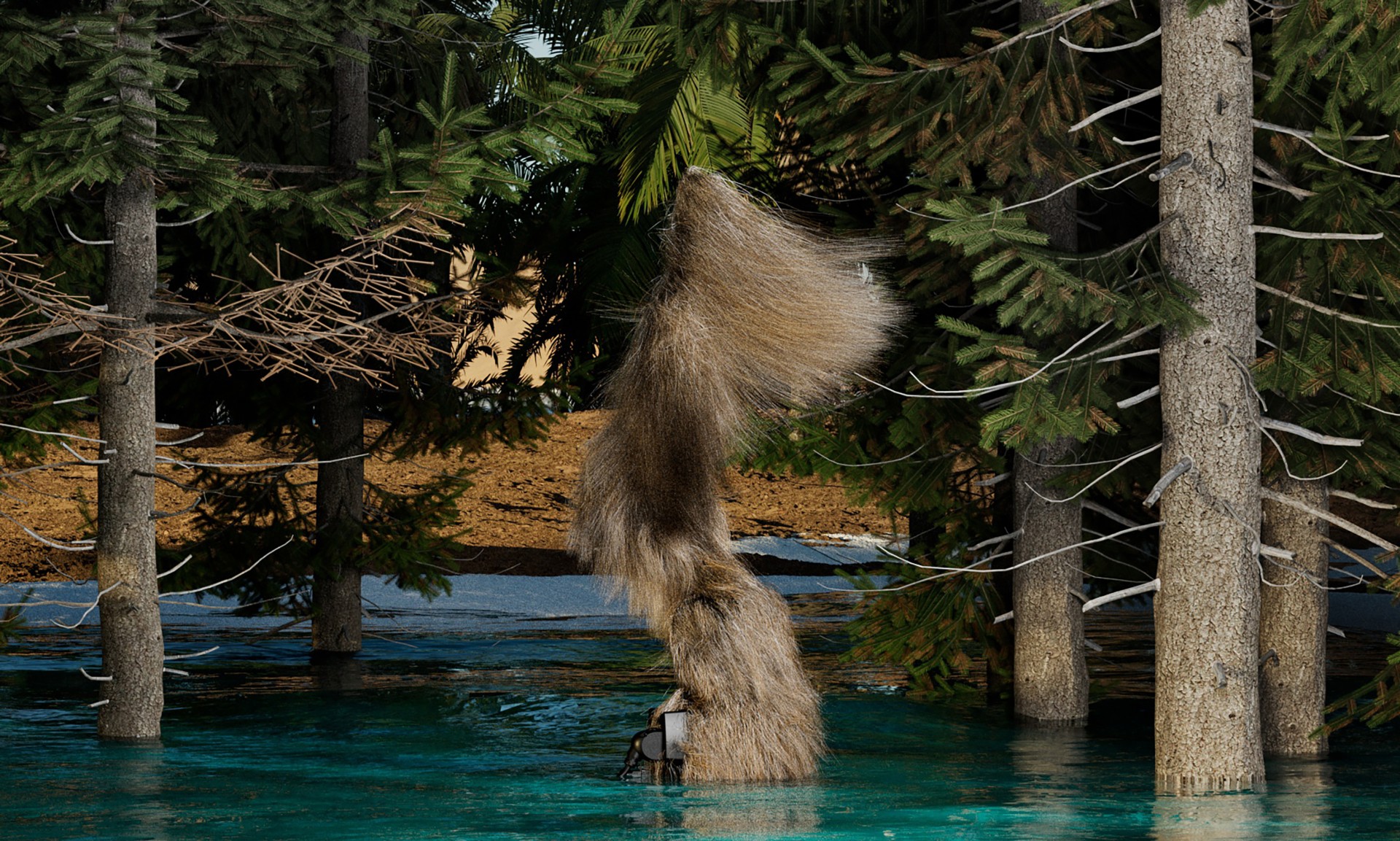Critical land.
Indigenous art and identity
04/19/2021
30 min reading time
In our new podcast series with Indigenous perspectives on art, nature, decolonisation and climate change, we talk with Algonquin-French artist Caroline Monnet.
Transcript
Sylvia Cunningham: Welcome to “Critical land”. I’m your host, Sylvia Cunningham. This is the second episode of an English-language podcast from the Schirn Kunsthalle Frankfurt debuting alongside its latest exhibition, “Magnetic North: Imagining Canada in Painting 1910-1940.” In this podcast series, we’re drawing from some of the themes in “Magnetic North” to go beyond what is displayed on the gallery walls through conversations with Indigenous artists and scholars. The exhibition examines modern Canadian landscape painting from a contemporary standpoint. It also features the film, “How a People Live,” from Anishinaabe filmmaker Lisa Jackson and “Mobilize” from Algonquin-French artist Caroline Monnet, whom you’ll be hearing from in today’s episode. Monnet’s immersive video installation, “Transatlantic,” is also on view in the publicly accessible Rotunda at the Schirn. A quick note — we talked about the Group of Seven in the first episode of “Critical land” with the exhibition’s curator Martina Weinhart and Lakota-Scottish art professor Carmen Robertson, so if you haven’t listened to those interviews yet, you can do so here. Now to today’s episode. Caroline Monnet is a multidisciplinary artist based in Montreal. She grew up in both Gatineau, Québec and Brittany, France. Her mother is Algonquin, her father is French, and she works with many different mediums, including filmmaking, sculpture, installation and painting.
[Audio from “Mobilize”]
What you’re hearing now is sound from Monnet’s short film, “Mobilize,” one of her works on view at the Schirn. The film has an incredible driving pace, from the music performed by Tanya Tagaq to the actions we see on camera. There’s one man masterfully paddling through the water, others are peeling birch bark to make a canoe. We also see scenes in the bustling city, including Mohawk ironworkers climbing atop steel girders. I asked Caroline Monnet how this film came to be.
Caroline Monnet: In 2015, the National Film Board of Canada approached me to rework materials from their archives. This was part of their “Souvenir” series, so we were four filmmakers across Canada to make a three-minute video with their archives. The only direction they gave us was to portray Indigenous identity, which I thought was a very abstract thing because for me there are many Indigenous realities. I had access to over 800 films, most of them were made from a white, male perspective, approaching Indigenous people from an anthropological standpoint where the protagonists are always presented as very passive, kind of busy working on their craft and really insisting on remaining at the margins of Canadian society. So, there’s kind of a tension between the original footage that was created during a time of historical chaos and the treatment of Indigenous people and between the remix that I did in “Mobilize.” Because I used these visuals, these films to kind of summon the mobilization of Indigenous people, nationwide. For me Indigenous identity is something vibrant and dynamic. It’s not something passive that is shown in these films. I wanted audiences to feel energized seeing Indigenous people showing off their skills on screen. That’s why I was particularly interested in images of people walking or building, canoeing, moving forward. For me this really counters the inertia too often portrayed in Canadian media.
Sylvia Cunningham: Even the fact that you were invited to do this within the framework of “Indigenous identity” — which is this term that’s singular, it’s monolithic — how did you approach it? Did you approach it from your personal background or how could you convey that it’s impossible to boil this down to a monolithic view?
Caroline Monnet: You cannot boil it down to a monolithic view because there are multiple realities of Indigenous identity, and there’s so much diversity within the big Indigenous community itself across Canada. I knew I didn’t want to go into the nostalgic realm of choosing black and white footage. That’s why I decided to go with 16mm color footage because to bring that kind of consistency from beginning to end of the film and where audiences would almost feel that I shot it myself. You start looking more at texture and colors and piecing each visual together, almost like a puzzle except you don’t know what the end image will be. You just piece it together and somehow start finding a narrative with all that. In some ways the film also represents my own family’s history. I didn’t grow up in my mom’s community but across generations, it evolves on the land. I think there’s a level of privilege that comes with the migration to the city, accessing jobs and education, but with that privilege comes a level of assimilation, trauma, and displacement. You start building a new narrative in these cities. I was really intrigued by that and the kind of notion of labor that is very different in the city, than out on the land and doesn’t require the same skill set and knowledge. So, the film was really about that. Overall, “Mobilize” is about pointing how Indigenous people were instrumental in shaping Canadian society, to the extent of building skyscrapers in our city. It was about saying our presence as Indigenous people can no longer be ignored.
Sylvia Cunningham: You mentioned you narrowed down the scope to 16mm color footage. How many hours of film was that then that you had access to work with then?
Caroline Monnet: I had access to 800 films, but you’d start typing keywords, because you can’t watch them all. The keywords were about “building” and “walking” and “Indigenous people walking,” “Indigenous people running,” “Indigenous people building.” I wanted the idea of being in action and not showcase a passive people. We’re not stagnant in time, we’re very active and we have a set of skills that are actually very celebrated. We’re part of this vibrant society, and we have our place within it, and I wanted to show that, so you have to work quite instinctively with that process, working with archives. I was using Tanya Tagaq’s soundtrack, which was instrumental in bringing that level of energy in the editing as well. I edited on the soundtrack and her music has this traditional connection while remaining very contemporary, almost like metal music, which I thought was really interesting. Her sound helped to use the archives to speak about the future.
Sylvia Cunningham: So, that came into process relatively early? I was going to ask about that. You knew you were going to be using Tanya Tagaq’s music and craft the footage to it, to build and match that track’s driving pace?
Caroline Monnet: Yes, absolutely. I had access to her album and I chose the most upbeat track on the album because from the very beginning it was clear to me that I wanted—because it’s only three minutes—to have this experience, create an experience for audiences where they would be almost plugged to the computer and be bombarded by images and then their heart would start pounding. They’d be out of breath and they’d be totally energized by seeing Indigenous people kicking ass on screen. You don’t really understand what just happened to you, but you have this level of energy, and it’s with Indigenous representation on screen. That was the main intention behind the film.
Sylvia Cunningham: It’s so mesmerizing and intriguing watching what everyone’s doing, there is really so much going on. In contrast, your other work at the Schirn, in the publicly accessible Rotunda, the video installation “Transatlantic,” is really devoid of human presence. For that work, which we’re hearing a little bit of the audio from now, you embarked on a cargo ship from a port in Europe and then traveled to where you live now, to Montreal. Can you describe what that journey was like for you?
Caroline Monnet: Well “Transatlantic” is a trip I took in 2012 on a cargo ship from the Dutch port of IJmuiden, just west of Amsterdam, all the way to Montreal, the Great Lakes in North America. It took me 22 days to cross the Atlantic Ocean. The whole journey was documented through a mini-DV handheld camera. The video carries different states of emotion that I felt at sea, like heavy tension, nervousness, boredom and even sometimes a bit of fear, when we hit storms, but also because I was in a male-dominated environment of shipping and industry. There were moments where I did ask myself, why I thought about doing this trip in the first place. The initial idea behind it is that for me, the transatlantic ocean was a middle ground for both my ancestors to meet. It was kind of a symbolic place. This idea of borders, whether they’re physical or metaphorical, has always been very present in my works, so it’s a continuation of that idea. I grew up between two continents, two cultures, so I’ve been fascinated with this idea of duality and how political and social histories shape your identity. We always say that identity is intrinsic to territory, but what does it mean when you come from two distinctive territories, how does that shape your identity? That was the kind of seed behind the project. I filmed it in 2012, but it took me a good six years to finish it. I finished it in 2018 and I’m glad it actually matured a little bit because then the project started looking into the Atlantic Ocean as an ongoing colonial movement and economic exchange between Europe and North America, and how colonization is a historical event defined by the transatlantic slave trade and the genocide of Indigenous people. So, it became a much more engaging piece rather than only a personal piece.
Sylvia Cunningham: What do you think it was in those six intervening years that allowed that framing and narrative to develop in your head? Was it a matter of research or other projects that influenced your reflections on it?
Caroline Monnet: I took the trip and then the tapes were sitting on the shelf for a long time, I just didn’t know what to do. I didn’t have a clear idea of what to do with it. I knew I did not want it to just be a documentary piece, that’s why I removed all the men at work. It’s very abstract, it becomes almost like a vessel traveling across a great divide. It’s more of an experience rather than a document. It was very important for me to create an immersive experience with it, and it took me this long, I’m not sure why. “Mobilize” was done in only one month, from start to finish, from concept to delivery of the product, and “Transatlantic” took me six years. I think I needed some level of maturity as an artist and as a thinker to envision some kind of installation rather than just a document that would play at film festivals.
Sylvia Cunningham: What we see at the beginning of the film is this more industrial scene with smokestacks and then and at the end of this whole voyage, we see a cityscape at night, with lots of buildings of course. I felt that those images are very anchoring because I know exactly where I am. But it’s the between where it’s just open waters, where you feel totally sucked in, where you feel like you can get lost. I’m wondering if that echoes a bit what it was like for you during your three-week journey. You were quite isolated, right? What was it like being out on the open waters where, like you said, it was just interaction with the crew, there was no connection to the outside world at all during those 22 days?
Caroline Monnet: No, which was an interesting concept. It’s true, you have no connection to phone or internet, you’re really out at sea for 22 days and it’s kind of a pocket of time… you can’t go anywhere, this is where you are. Very interesting experience, all your references points, they all disappear because there are no markers on the horizon, it’s always the same. You start getting into a different state of mind which is a very intriguing place to be.
Sylvia Cunningham: Something that my mom says, which I’m not totally sure I agree with, is that the best part of a trip is the part before, the planning stage, looking forward to everything, the anticipation of the trip. And the afterwards, the memories of it and kind of reliving it. What were your emotions upon arriving home to Montreal? The first night you were back on your bed, were you relieved or was a part of you already romanticizing being back on the open waters. How did your return feel?
Caroline Monnet: I think there was a level of romanticizing the idea of crossing the Atlantic Ocean, it’s the mythological route of my father coming to France, migrating to Canada, and so many other people, so many other generations and settlers’ experiences. But yes, I was ecstatic when I arrived in Montreal to finally step foot on land, because it’s a long trip, you long for the people, for the connection to the people you love. It was an interesting journey, but I’m not sure I agree with your mom on that one. There’s something about going from point A to point B, the journey is what is fascinating how you grow as a person, and the idea of crossing a line or something. The journey itself is interesting.
Sylvia Cunningham: Both of your works are being shown at the Schirn at the same time the Group of Seven’s work is being displayed there, for the first time in Germany actually. How have you reflected on that context, especially knowing for visitors that they’ll be presented with these different dimensions of art originating from people in Canada.
Caroline Monnet: Well definitely growing up in Canada, the Group of Seven is kind of the first reference you have of painting and Canadian art in general. Every child in Canada has grown up on it. You know all the great painters like Rembrandt, Picasso, but you also know the Group of Seven, so we come to understand Canada through those paintings. You especially come to understand the representation of Canadian landscape through those paintings. But I guess my interpretation of it is that these paintings contributed to telling a story that is very different from the Indigenous perspectives because it was really about this pristine, uninhabited, super territories, waiting to be discovered. They call it the “terra nullius” although it was habited for centuries already. To simply remove that Indigenous history from those stories, to remove the Indigenous presence from that history is perpetuating the colonial gaze, the erasure of Indigenous stories and people and the displacement of Indigenous people. It’s a bittersweet relationship with those paintings and the Group of Seven. Technically they’re spectacular and it’s a great movement, but at the same time, it contributes to exactly what we’re fighting against.
Sylvia Cunningham: Something we talked about in the first episode of “Critical land” with Professor Carmen Robertson was the difference between land and landscape. What do those terms mean to you?
Caroline Monnet: Landscape for me is a representation of topography and it’s something that is beautiful and that you can almost imagine, it’s part of an imagination. You can describe a landscape. Whereas land is where we belong, it’s where everything originates. We cannot possess the Earth, it’s the Earth that possesses us, we come from that and we go back to that. I think land is the notion of territory and the center of all people because that’s where all the roots of our knowledge is from—our languages, our tradition, our sense of belonging and sense of identity—so I think there’s multiple territories, multiple lands. There’s a diversity of it and I think we can only speak of the land we come from. I don’t think I could speak for “Canadian land,” I only know the place where I come from and the region I come from in Canada and the connection that I have with that land in particular and where my people have connection to that land as well.
Sylvia Cunningham: I was watching a previous interview that you did, and I hope I’m understanding what you said correctly, but you were talking about how you’re interested in Indigenous artists looking back at and reflecting on various art movements. How would you apply your perspective to the Group of Seven’s landscape paintings and the time in which they were painting in—that movement?
Caroline Monnet: Wow, that’s a really good question. I don’t know because it’s a movement in itself, but how would you call that movement in painting? It’s quite figurative so I’m not sure it’s a movement that I would instinctively explore such as Modernism, or Dadaism or Surrealism, where it becomes a real movement worldwide. This particular group is very particular to Canada and the representation of landscape. They’re kind of explorers on the land, right? They set up out on the land and they try to represent it to the best of their abilities, but also adding their own settlers’ gaze, so it’s also a level of their own imagination that’s embedded in the work. It’s a really good question, I’ll have to reflect on that one, how would I appropriate it from my own Indigenous lens.
Sylvia Cunningham: You come from both Algonquin and French heritage, and I’ve seen how you’ve previously talked about marrying traditional practices with contemporary practices. That your work is often building bridges. Did you learn about your Algonquin ancestry and heritage through your own upbringing, or have you come to learn more about this history and traditions as an artist who is specifically confronting these themes in your art?
Caroline Monnet: I would say as an artist, I was doing work that is research-based. It allowed me to go deeper into these notions and this knowledge and learning more about where I come from, but it’s something that was always present growing up, it’s just not something you’d talk about around the kitchen table. You don’t really talk about your culture at home, it’s not something you start defining with your parents, or your siblings, or aunts and uncles. It’s more as an artist when I start looking into topics that are important to me and wanting to discuss certain things in our society and wanting to open dialogue about certain issues of our society, then I start digging more and looking into more traditional art or traditional teachings, and just looking more into where my people come from. I grew up in suburbia of Ottawa, so I didn’t grow up in my mother’s community. We would go back for funerals, or weddings, but it wasn’t something that was super celebrated growing up. It’s only later, when it became a little more accepted in Canadian society, that I was able to dig a bit deeper.
Sylvia Cunningham: Has that since become a bridge to your mother and extended family? I mean, has it become something you maybe would talk about around the kitchen table?
Caroline Monnet: Maybe a little bit more because now it’s so embedded in my life and the work that I do. So yes of course if my mom asks me what I’m working on I’ll tell her more about it or just the people that I have in my surroundings. It took only four generations with cultural genocide to erase us. Not even 50 years ago we weren’t allowed to express ourselves creatively so there’s a certain level of responsibility that comes with the new generation, and my generation to be able to be present and keep those traditions alive. There’s kind of a gap between my grandfather and myself, just to be able to work to bridge that gap and to bring that back into my own family and my own surrounding.
Sylvia Cunningham: I’d love to touch on one more of your films, “Creatura Dada.” I was planning on describing it myself, but actually I’d love if you would describe it instead, what this short film is.
Caroline Monnet: It was the 100th anniversary of Dadaism and I was asked by the Festival du nouveau cinéma in Montreal to create a Carte Blanche, to make a very short video. I had the “white page complex,” I didn’t know what to do. So I decided to take the small budget they offered me and invite Indigenous Francophone women at my table to make a feast and buy champagne and treat them to a nice afternoon experience. It’s very rare that we get the chance to get together and just exchange and dialogue and spend time together. These women are prominent leaders of their communities, they’re artists like Nadia Myre but also Alanis Obomsawin who is this amazing role model for the Indigenous communities. I filmed the entire experience and it was about breaking all rules because they don’t suit us in Canadian society and reinventing the world as we see fit. It was about marching forward as women, as leaders of our communities.
Sylvia Cunningham: And again, listeners should definitely watch this after the interview, because as you describe it, it is this gorgeous party and there’s so much laughter and so much life. I think especially right now, especially when dinner parties are basically a no-go during the pandemic, there’s something especially entrancing about watching that.
[Audio from “Creatura Dada”]
We should note, you can’t hear the original sound. So, it begs the question, what were you all talking about. Can you describe what the sound is, what we’re hearing instead and what made you not include the original sound?
Caroline Monnet: It felt like we needed to keep that secret. We can’t reveal everything because we were planning a revolution, we can’t let everyone know about it, because then the plan doesn’t work! And everybody’s going to know about it. It’s also interesting because all this food is considered high-end food in gastronomy, but most of it is very local, traditional food—lobsters, oysters. I made this film after there was a big issue in the media about Indigenous women being abused by police officers in the Abitibi region and this film was a bit of response about countering the negative, victimized image of Indigenous people or women especially in the media. Women are still the most marginalized group of Canadian society. I wanted to show women as being eccentric, beautiful, exuberant, elegant, and raise them back on a pedestal, to raise them back to a level of royalty. That was the intention behind the film.
Sylvia Cunningham: I came across this quote recently from a musician that the “pandemic is not a residency” or an “artists retreat,” in response to external or maybe self-applied pressure to produce new work and be super creative in lockdown. How has it been for you?
Caroline Monnet: It’s been a good time in terms of slowing down a little bit because as artists we’re always in the stage of producing and presenting and representing. To take the time to not travel as much, to reflect more on research and prepping for what’s to come and reorient the work you’re doing, it’s been good. I was working on finishing my first feature film, which was good for me to take more of my time in post-production rather than rush it and move onto the next project. I took a little bit of break and never approached it as a time of creating, it didn’t really slow down for me, I had to work differently I would say.
Sylvia Cunningham: That feature film, “Bootlegger,”—which you co-wrote and it won best screenplay at the Cannes Film Festival in 2017—can you tell us a bit about where you are with it, also what it’s about and when we can see it?
Caroline Monnet: The film is in the final stages of post-production. We shot it in December 2019 and we’re just finishing it now. Hopefully we’ll be able to release it a little bit later on this year, maybe this summer or next fall. But that’s really out of my hands, it’s the production company and the rest of the people that are going to organize all of that. But it’s exciting to be able to make a first feature film. It’s a bit nerve-wracking to be doing such a project in a time of pandemic because we don’t know how these films are going to end up—if we’re going to have people in cinemas, if we’re going to have film festival premieres, is it going to end up online? And there’s a little bit of a disappointment because you work five years on a project to have it end up online and people watch it on their screens. But it’s also a different experience and maybe it can reach more people this way. We adapt, and there’s good and bad for everything.
Sylvia Cunningham: The musician Tanya Tagaq, who provided music for “Mobilize,” will also be doing the music for “Bootlegger,” right?
Caroline Monnet: Exactly, it’s an ongoing collaboration. I was really happy Tanya Tagaq accepted to do the music. She worked in collaboration with Jean Martin, who she collaborates with usually. I’m very happy with the way it turned out and the sounds that they created together.
Sylvia Cunningham: How do you find that the music complements the plot and themes of “Bootlegger”?
Caroline Monnet: “Bootlegger” is about self-determination and taking destiny in your own hands, breaking away from paternalistic laws. The music is about the connection to land, territory, wanting to break free. Tanya Tagaq has the perfect sound and energy for these things. It’s this longing for self-determination, so I was really happy with the merging of my visuals with that music.
Sylvia Cunningham: You work on multiple projects at once. Do you find the ideas that you’re working through in one piece will kind of find their way into another? Or do you keep them very separate?
Caroline Monnet: It’s very ebb and flow, I don’t plan anything in advance. I feel that each project leads to the next one, and my practice is quite instinctive. It’s about experimenting with the work but also with myself and hoping to evolve as an individual and making sure that the work evolves with each project. Working with different disciplines keeps me on my toes, it keeps me invested and interested. Also, it keeps me outside of my comfort zone, and I think that’s where I can grow as an artist and a person, where I can learn. But the themes and the issues and the way I approach each project is the same, my level of interest is the same, and there’s always social engagement. I studied sociology, so there’s always a lot of social background to each project that I do, whether it’s in visual or sculptural form or video form. It’s always very present, that kind of sociology background. It’s very research-based and visual. Even in filmmaking, there’s not that many dialogues, no too many words. It’s about creating an experience, an emotional experience with as little words as possible. It’s a minimal approach.
Sylvia Cunningham: This year, you’ll have your first solo exhibition at the Montreal Museum of Fine Arts. Can you share with us what you’re working on for that?
Caroline Monnet: Yes, the show will be titled “Ninga Mìnèh.” It’s a word in Anishinaabemowin which means “I give it to you” or it’s the word we use for “promise.” I looked at the housing situation in Indigenous communities that have remained grievously unchanged over the years. In remote regions with harsh winters, construction materials can be scarce and very expensive. They’re not very adapted to the environment there in the north, so there’s a housing crisis. I wanted to speak about that and the lack of vision from the Canadian government. I believe that we make our houses and our houses make us, so if we use cheap materials and if there’s lingering moisture that creates mold, that definitely affects our mental, physical, and spiritual health. I think houses should be treated as living bodies, so the entire exhibition is about that, it’s using construction material with embedding traditional-inspired designs. It’s about taking a look at how the federal housing system has been an agent in creating poverty in these communities and what we can do. Offering or hoping to open a dialogue about it.
Sylvia Cunningham: If we make our houses and our houses make us, how do you think your house makes you and how do you make it? Do you think you apply that personally to how you build your home?
Caroline Monnet: Yes, absolutely. I put a lot of care in my environment. I really believe we affect the environment around us and the environment affects us. We always imagine the people representing the places they live in, but in the case of certain Indigenous communities, I don’t think that’s true. I think there’s a lack of resources to create proper homes. This exhibition wants to break those preconceptions and break those negative stereotypes. In my case, right now my studio is quite busy, but usually it’s pretty organized and clean. Every time I start a new project, I’ll make sure that I do a clean-up, just to have that mental space to clear things up. I don’t like clutter, but that’s me. I mean other people are comfortable with that. I personally need some white walls to be able to imagine other things.
Sylvia Cunningham: Caroline Monnet, multidisciplinary artist whose works, “Mobilize” and “Transatlantic” are on display at the Schirn. Thank you so much for joining me.
Caroline Monnet: Oh, my pleasure.
Some of the artists and filmmakers Caroline Monnet says inspire her include: Teresa Margolles, Lisa Reihana, Maya Deren, Theaster Gates and Apichatpong Weerasethakul.
Subscribe to SCHIRN podcasts on:
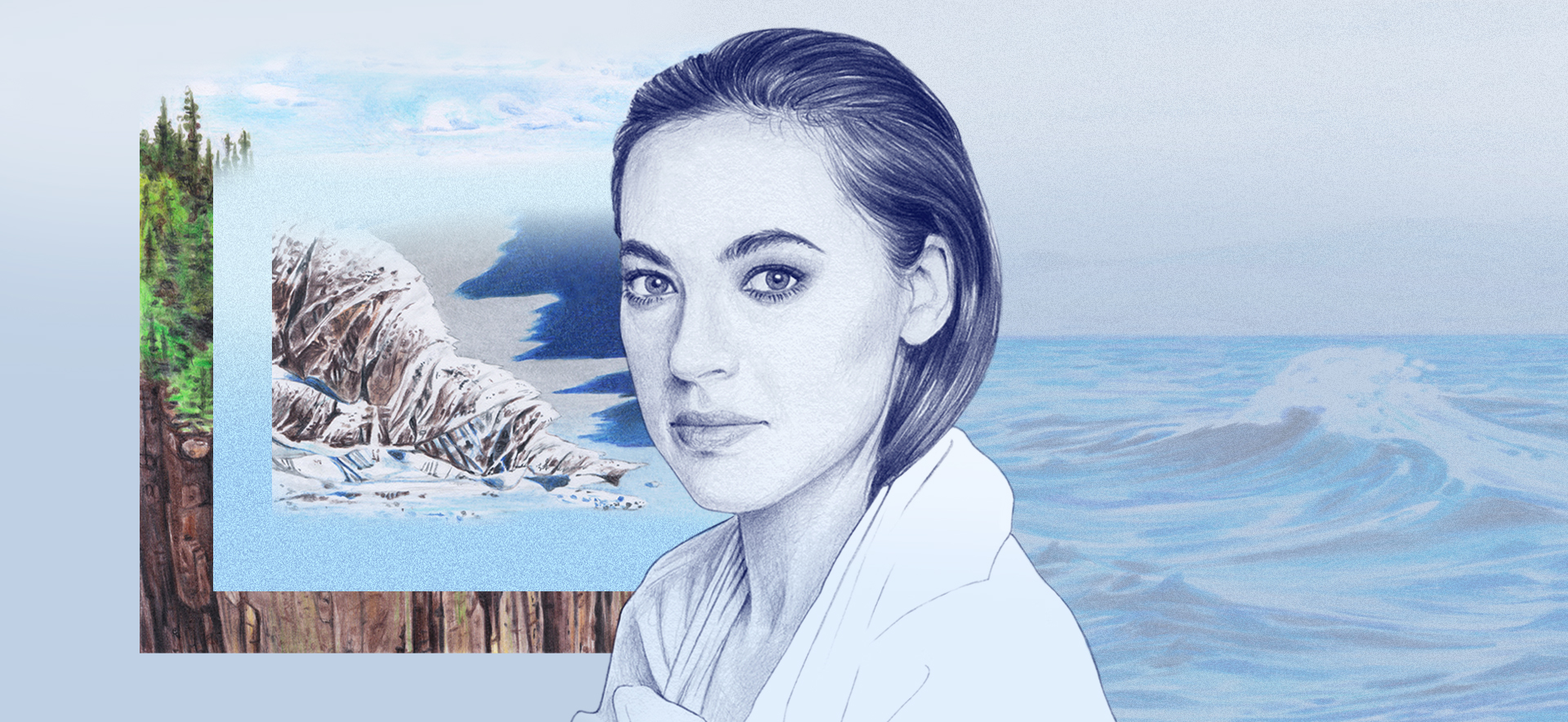
You may also like
Lorem ipsum dolor sit amet, consetetur sadipscing elitr, sed diam nonumy eirmod tempor invidunt.
Lorem ipsum dolor sit
- Interview
SCHIRN Questionnaire: Amna Elhassan
Brand new: Our HERE WE ARE collection
- Discourse
Bobbies on the Bathroom Beat
- Interview
About Time. With artist Helga Fanderl
Here we go Bockenheim!
- Video Art
Art meets AI: Twixt tool and being
- DiscourseInterview
The Meaning of ‘Artificial’ Life
- Sound
Here we go Bockenheim!
